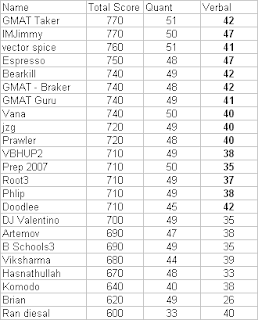Some members asked me what's "best" way to tackle GMAT quantitative questions. Well, I don't have the "best" answer but I have approached quant questions from different angles during my study and came out with one that suits me. You can give it a try and see if it suits you (always find an approach that you will be comfortable with).
In earlier blog, I wrote about
"2-4-6" rule. I am sure someone might have invented this but let's say I gave it a name. Let's recap this rule: 2 minutes per quant question, 4 steps for "easy" question and 6 steps for "hard" question.
Now, we take this rule a few steps further. My approach to quant questions as follow:
1. When you read the stimulus and question stem, immediately take note of the topic(s) and sub-topic(s) you are being tested on. Yes, at times, especially "harder" questions, you are being tested on two or more topics or sub-topics. Therefore, your ability to syntisize the questions and pull them together helps a lot.
You might be asking what I do mean by "topic" or "sub-topic". GMAT Malaysia is using ManhattanGMAT Prep books as our guides; thus, you will find the structures in their books. As you study, you should build into yourself the principles and rules covered in each sub-topic.
2. Once you know what is being tested, immediately you should recall the principles and rules.
3. Now, apply those principles and rules to answer the question stem. Is it about Prime Factorisation? What do I need to know about prime numbers? What are prime numbers?
4. Most of time, the stimulus is in 2-3 sentences. Convert them into algebraic equation(s). This is what GMATters call "rephrasing".
5. Once you do this, you can see what the question is actually asking and at times, the answer just pops right in front of your face.
6. Look for the answer. At times, the answer is in another form e.g. in the form of inequalities. In this case, you think to know the rules of inequalities.
Okay, so much talk, show me the action. Here is one question from Official Guide (11th Edition):
PS Q26: If the quotient a/b is positive, which of the following must be true?(A) a > 0(B) b > 0(C) ab > 0(D) a-b > 0(E) a+b > 0This question is testing you on
Positive/Negative Values and
Divisibility but the answer choices are given in form of
Inequalities.
When you rephrasing this question, value (
a/b) being greater than 0. For
a/b to be greater than 0, both
a and
b must be positive or negative. Either one cannot be negative, or the stimulus will not be true (in this case, the stimulus is
a/b > 0).
Let's examine each answer choice.
(A)
a > 0, but says nothing about
b. Not determinable.
(B)
b > 0, and like answer choice (A), says nothing about
a. Not determinable.
(C) For
a * b > 0,
a and
b must be positive or negative AND neither one can be negative. This is what we are looking for when we analyse the stimulus.
Correct(D)
a - b > 0. If
a is positive, then
b must be smaller than
a such that will still result in
a - b as a positive number. Or,
a can be negative and
b can be negative such that the
b is greater than
a. Too many possibilities, not sure what values
a and
b could be. Not determinable.
(E)
a + b > 0. If both
a and
b are positive, then this is correct. If
a and
b are negative, then this is incorrect. Or, either
a or
b is negative, then it dependable on which value is smaller negative value. Again, not determinable.
What I have done in analyzing and breaking down the stimulus is restating the stimulus into these two conditions:
i. For a/b to be greater than 0, both a and b must be positive or negative. ii. Either one (a or b) cannot be negative, or the stimulus will not be true And, answer choice (C) met these two conditions.
Get yourself into this regime and soon you will ace in both problem solving and data sufficiency questions.
Jimmy Low











